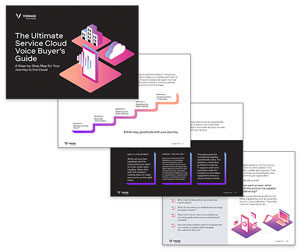Ashley Unitt of NewVoiceMedia shares four trends in Artificial Intelligence (AI) that may impact the contact centre industry.
Technology in today’s Age of the Customer is simultaneously increasing customer expectations and making service more complex.
In the last few years, smarter algorithms, AI, self-service channels and analytics have exploded.
This wave of innovation is also bringing exciting opportunities for service managers to transform their brand’s customer experience. Bluewolf, an IBM company, predicted that AI will impact customer service in four key areas in 2018.
1. Understanding — Integrating and assimilating external market data (social, personality, or segmentation) for directed selling or personalisation.
2. Interacting — Chatbots, virtual assistants, or conversational apps that deflect inbound customer requests or automate process-driven, repetitive tasks.
3. Answering — Unlocking deep knowledge discovery, assisting employees in quickly and accurately recommending answers to complex customer requests.
4 Guiding — Predictive and machine learning models to instruct next-best action with the customer.
Here’s a closer look at each of these areas, along with trends to look out for at Dreamforce that can help your brand capitalise on AI’s service-boosting capabilities.
Understanding
Advanced analytics, powered by artificial intelligence and machine-learning technologies, can now help businesses comb through huge, previously unstructured data sets to discover what customers are thinking and feeling.
These tools can capture powerful data from contact centre calls, social media, and messaging apps, combine it with information from the customer relationship management system, and arm service agents with real-time intelligence such as which products a customer owns, open cases, VIP caller status and sentiment.
Using this highly targeted data, businesses can personalise each customer conversation to build rapport, deliver better advice and recommendations, and establish the emotive interactions that have become so key to the customer experience.
Service managers can also use these insights to improve their teams’ operations, reduce potential frustrations in the customer journey, and coach agents’ communication skills to ensure customers can solve problems more efficiently and feel good at the end of each conversation.
Interacting
A recent report revealed that there are now more than 100,000 Facebook Messenger bots for businesses, providing customers with the one-on-one service they crave as well as offering companies key insights into purchasing behaviour.
Additionally, Salesforce recently announced the next generation of Service Cloud Einstein, which will enable businesses to leverage Salesforce’s Einstein Bots for Service.
Einstein Bots automate routine service requests by immediately responding to and gathering basic information from customers. They also use machine learning and natural language processing and improve with every interaction.
Chatbots and virtual agents help connected customers feel empowered. They cut out the middleman, allowing customers to resolve basic enquiries without having to pick up the phone. While using self-service as the first point of contact for simple support issues, the role of the live agent will be even more heightened in this era of customer empowerment.
While the emerging AI/bot technology will enable better self-service, businesses should still continue to focus on enhancing the human experience by augmenting the chatbot interactions for an overall better experience.
Even though we have the technology to automate most things, research indicates that seven out of 10 people still believe that speaking to someone on the phone is the fastest way to resolve an issue. For this reason, businesses will need to find the right balance between automation and human support to deliver the service that customers demand.
Freed from dealing with simple requests, contact centre agents will be able to spend more time handling cases that are complex or emotionally driven. For this reason, it’s crucial that businesses provide consistency when escalating customer support from digital self-service to human agents and, sometimes, back again.
A contact centre solution with intelligent tracking and routing features enables you to seamlessly transfer interactions from digital to voice while maintaining a complete record of all customer interactions across channels. This means your reps can see the effort customers have already invested and the complete context of their journey, making problems easier to solve and potentially difficult conversations run more smoothly.
Answering and Guiding
Salesforce’s next generation of Service Cloud Einstein builds on Bots with Lightning Flow for Service, which enables businesses to provide a self-service experience that leads customers through interactions and guides agent workflow (e.g. fulfilling requests, resolving issues), and Einstein Next Best Action, which uses rule-based and predictive models to empower agents with intelligent, contextual recommendations and offers for customers.
Although AI-enhanced solutions will help customers solve many of their problems through self-service, there will always be make-or-break moments in the business–customer relationship that require the skills of a human agent. Deep integration between your CRM and contact centre enables all digital and voice channels to draw on the same data for a richer, deeper understanding of not only previous interactions, but also where the customer’s journey may lead them next.

Ashley Unitt
Tools like NewVoiceMedia’s speech analytics solution, Conversational Analyzer, can offer even more insight. Combining data from voice calls and your CRM, speech analytics can dig deep into conversations to learn what customers want — sometimes, before they even know it themselves.
For example, analysing call data allows managers to identify how customers are responding to different offers and what impact they have on satisfaction levels. This information can then be used to create personalised up-sell and cross-sell suggestions.
This blog post has been re-published by kind permission of Vonage – View the Original Article
For more information about Vonage - visit the Vonage Website
Call Centre Helper is not responsible for the content of these guest blog posts. The opinions expressed in this article are those of the author, and do not necessarily reflect those of Call Centre Helper.
Author: Vonage
Published On: 17th Sep 2018 - Last modified: 2nd Oct 2018
Read more about - Guest Blogs, Vonage






 Vonage is redefining business communications, helping enterprises use fully-integrated unified communications, contact centre and programmable communications solutions via APIs.
Vonage is redefining business communications, helping enterprises use fully-integrated unified communications, contact centre and programmable communications solutions via APIs. 










